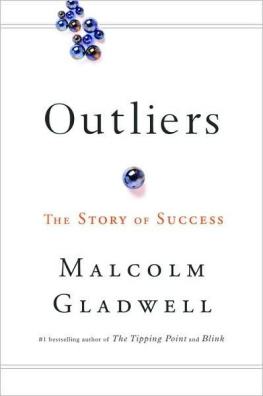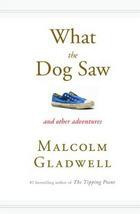Contents
INTRODUCTION
The Roseto Mystery
These people were dying of old age. Thats it.
ONE
The Matthew Effect
For unto everyone that hath shall be given, and he shall have abundance. But from him that hath not shall be taken away even that which he hath. Matthew 25:29
TWO
The 10,000-Hour Rule
In Hamburg, we had to play for eight hours.
THREE
The Trouble with Geniuses, Part 1
Knowledge of a boys IQ is of little help if you are faced with a formful of clever boys.
FOUR
The Trouble with Geniuses, Part 2
After protracted negotiations, it was agreed that Robert would be put on probation.
FIVE
The Three Lessons of Joe Flom
Mary got a quarter.
SIX
Harlan, Kentucky
Die like a man, like your brother did!
SEVEN
The Ethnic Theory of Plane Crashes
Captain, the weather radar has helped us a lot.
EIGHT
Rice Paddies and Math Tests
No one who can rise before dawn three hundred sixty days a year fails to make his family rich.
NINE
Maritas Bargain
All my friends now are from KIPP.
EPILOGUE
A Jamaican Story
If a progeny of young colored children is brought forth, these are emancipated.
ALSO BY MALCOLM GLADWELL
Blink
The Tipping Point
What the Dog Saw
For Daisy
Introduction
The Roseto Mystery
THESE PEOPLE WERE DYING OF OLD AGE. THATS IT.
outlier \-,l(-)r\ noun
1: something that is situated away from or classed differently from a main or related body
2: a statistical observation that is markedly different in value from the others of the sample
1.
Roseto Valfortore lies one hundred miles southeast of Rome in the Apennine foothills of the Italian province of Foggia. In the style of medieval villages, the town is organized around a large central square. Facing the square is the Palazzo Marchesale, the palace of the Saggese family, once the great landowner of those parts. An archway to one side leads to a church, the Madonna del Carmine Our Lady of Mount Carmine. Narrow stone steps run up the hillside, flanked by closely clustered two-story stone houses with red-tile roofs.
For centuries, the paesani of Roseto worked in the marble quarries in the surrounding hills, or cultivated the fields in the terraced valley below, walking four and five miles down the mountain in the morning and then making the long journey back up the hill at night. Life was hard. The townsfolk were barely literate and desperately poor and without much hope for economic betterment until word reached Roseto at the end of the nineteenth century of the land of opportunity across the ocean.
In January of 1882, a group of eleven Rosetans ten men and one boy set sail for New York. They spent their first night in America sleeping on the floor of a tavern on Mulberry Street, in Manhattans Little Italy. Then they ventured west, eventually finding jobs in a slate quarry ninety miles west of the city near the town of Bangor, Pennsylvania. The following year, fifteen Rosetans left Italy for America, and several members of that group ended up in Bangor as well, joining their compatriots in the slate quarry. Those immigrants, in turn, sent word back to Roseto about the promise of the New World, and soon one group of Rosetans after another packed their bags and headed for Pennsylvania, until the initial stream of immigrants became a flood. In 1894 alone, some twelve hundred Rosetans applied for passports to America, leaving entire streets of their old village abandoned.
The Rosetans began buying land on a rocky hillside connected to Bangor by a steep, rutted wagon path. They built closely clustered two-story stone houses with slate roofs on narrow streets running up and down the hillside. They built a church and called it Our Lady of Mount Carmel and named the main street, on which it stood, Garibaldi Avenue, after the great hero of Italian unification. In the beginning, they called their town New Italy. But they soon changed it to Roseto, which seemed only appropriate given that almost all of them had come from the same village in Italy.
In 1896, a dynamic young priest by the name of Father Pasquale de Nisco took over at Our Lady of Mount Carmel. De Nisco set up spiritual societies and organized festivals. He encouraged the townsfolk to clear the land and plant onions, beans, potatoes, melons, and fruit trees in the long backyards behind their houses. He gave out seeds and bulbs. The town came to life. The Rosetans began raising pigs in their backyards and growing grapes for homemade wine. Schools, a park, a convent, and a cemetery were built. Small shops and bakeries and restaurants and bars opened along Garibaldi Avenue. More than a dozen factories sprang up making blouses for the garment trade. Neighboring Bangor was largely Welsh and English, and the next town over was overwhelmingly German, which meant given the fractious relationships between the English and Germans and Italians in those years that Roseto stayed strictly for Rosetans. If you had wandered up and down the streets of Roseto in Pennsylvania in the first few decades after 1900, you would have heard only Italian, and not just any Italian but the precise southern Foggian dialect spoken back in the Italian Roseto. Roseto, Pennsylvania, was its own tiny, self-sufficient world all but unknown by the society around it and it might well have remained so but for a man named Stewart Wolf.
Wolf was a physician. He studied digestion and the stomach and taught in the medical school at the University of Oklahoma. He spent his summers on a farm in Pennsylvania, not far from Roseto although that, of course, didnt mean much, since Roseto was so much in its own world that it was possible to live in the next town and never know much about it. One of the times when we were up there for the summer this would have been in the late nineteen fifties I was invited to give a talk at the local medical society, Wolf said years later in an interview. After the talk was over, one of the local doctors invited me to have a beer. And while we were having a drink, he said, You know, Ive been practicing for seventeen years. I get patients from all over, and I rarely find anyone from Roseto under the age of sixty-five with heart disease.
Wolf was taken aback. This was the 1950s, years before the advent of cholesterol-lowering drugs and aggressive measures to prevent heart disease. Heart attacks were an epidemic in the United States. They were the leading cause of death in men under the age of sixty-five. It was impossible to be a doctor, common sense said, and not see heart disease.
Wolf decided to investigate. He enlisted the support of some of his students and colleagues from Oklahoma. They gathered together the death certificates from residents of the town, going back as many years as they could. They analyzed physicians records. They took medical histories and constructed family genealogies. We got busy, Wolf said. We decided to do a preliminary study. We started in nineteen sixty-one. The mayor said, All my sisters are going to help you. He had four sisters. He said, You can have the town council room. I said, Where are you going to have council meetings? He said, Well, well postpone them for a while. The ladies would bring us lunch. We had little booths where we could take blood, do EKGs. We were there for four weeks. Then I talked with the authorities. They gave us the school for the summer. We invited the entire population of Roseto to be tested.












